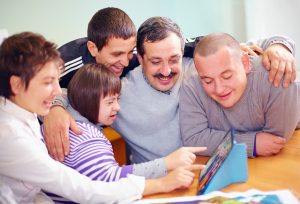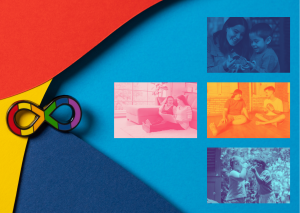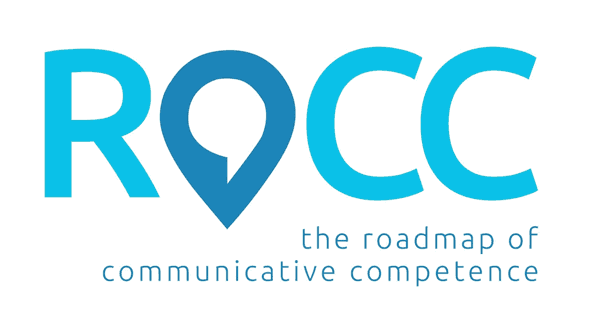This featured domain discussion is around Domain #9, SOCIAL INTERACTION AND BUILDING RELATIONSHIPS
The goal: To use their system in as socially valued manner as possible and for social interaction that builds relationships.
It is beyond the scope of the ROCC Assessment to consider all aspects of social interaction and the diverse preferences of all individuals in this regard. However, the aim of Domain #9 is to highlight areas for consideration with regard to an individual’s success within social interactions. These include techniques such as turn taking, topic maintenance, and strategies to engage communication partners.
It is important to understand that Domain #9 is a broad domain which can only touch on some of the considerations about the way in which the individual interacts with others. The items in this domain are an attempt to prompt discussion or enable planning for further development as well as practise skills if required.
Social interaction is complex and subjective, and is influenced not only by skills and experiences, but also personality, personal preferences and variations in communication partners and settings. For this reason, scoring on Domain #9 should not be a judgement but simply a consideration of possibilities and a focus for detailed attention if required.

Why is this domain important?
Communication is a Two Way Street and social domain skills include interpersonal dynamics, such as knowing how to put partners at ease, actively participating in conversations, and other pragmatic discourse strategies. Individuals with communication challenges need access to language that supports social interaction, and often instruction in how to participate in these interactions successfully. (Light, (1989), Beukelman and Light, 2020). Ultimately a successful interaction is dependent on both partners, and is often unique to each partner combination. When partners are familiar, interactions can be more intuitive and practised. They often require less effort and skill for each partner. But as our social networks expand, interactions with less familiar partners require additional strategies and skills to ensure success. ROCC aims to highlight some of these areas for consideration.
According to Maslow (1943), belonging and love are essential human needs, second only to survival and safety. No matter how we choose to interact socially with others, it’s an important consideration for any communicator. Words are only part of the equation. Sometimes we see individuals who have developed complexity in language (Domain 6) without social interaction and other times the opposite. Some individuals can engage socially using informal communication such as body language and gesture but are not always able to expand on those interactions with less familiar partners through vocabulary and syntax. Most people are somewhere in between. It is important that we consider social interaction as one of the foundations of communication development, as well as one of the vehicles through which we can enable someone to expand their communication in other areas.
A word about neurodiversity

When setting goals within this domain, it’s important to consider authentic social interaction from the perspective and values of the individual rather than an expectation based on neurotypical values. The descriptors within this domain relate to social interactions as a two way process and the term ‘socially valued’ may differ within environments, partners or as societal norms change.
It would be ideal if societal acceptance of neurodiversity were much further progressed, however it is also important to consider an individual in the context of their wider community. For this reason, there is a significant distinction in this domain between interaction with familiar and unfamiliar people. In fact, level 5 on Domain #9 describes, “the individual is able to communicate effectively with a range of people in most contexts in a way that can build social relationships”. This means that to score at this level, interaction in most contexts should be successful and socially valued.
However, there is absolutely no expectation for a person to mask (ie. conceal their natural tendencies) in order to “fit” into neurotypical expectations of social interaction, but rather to engage in their own decision making with regard to interactions with others.
The difference in scoring between level 4 and 5 in Domain #9 is the ability to engage socially with unfamiliar partners through any means, and if the individual so chooses. Levels within this domain may be related to skill development for an individual, but may also include strategies that build a shared understanding of communication from diverse perspectives such as training, accommodations and self advocacy strategies. Some of these are discussed below and are applicable to all communicators.
An individual may also choose not to engage with any social interaction strategies, and score at level 4. As we always say in ROCC, it’s not the score that counts but the conversations we have when considering the score.
The Double Empathy Problem: In the future, we hope that the term socially valued will be a more inclusive term as the general public increases their understanding of diverse communicators. This will mean that social interaction with unfamiliar partners will require less work or compensation on the part of the neurodivergent communicator. Until then, it is still important to consider what is generally seen as socially valued and consider ways that we can respectfully enable people to engage socially with all of the people and in the environments of their choosing.
Scoring notes
Though we can endlessly debate terms like socially acceptable and socially valued, the key to this domain is the use of these skills to build relationships. In particular, the focus is on relationships of the individual’s choosing. When we keep this end goal in mind, descriptors, strategies and skill levels may change but the underlying need for love and belonging are met through development of these relationships.
The end goal
In this domain, the end goal is simply that a person has all of the tools they need at any given time to communicate in the most efficient way possible. It is not a requirement to carry something around if it is not needed, but beware that you first consider that communication opportunities are usually not predictable and we don’t always know when and what someone will need to say. Better to be ready – just in case!

What can I do?
As with descriptors in this domain, the strategies to build skills or accommodate within a social interaction are diverse and personal. In this post, we will focus on accommodation strategies to enable successful interactions rather than skill development, as there is a significant body of information available in regard to social skill learning.
In order to ensure successful interactions between individuals, a shared understanding is crucial. As a starting place, it is important that communication partners acknowledge and respond to existing authentic communication that will sustain interaction. This may look very different depending on the communicator but it is crucial to ensure that genuine attempts for connection are respected.
Between familiar partners, a shared understanding may have already been established and relationships developed (or under construction). There are however partner training and self advocacy strategies that can enhance interaction with unfamiliar and often uninformed partners. The outcome is a positive interaction for the individual as well as enhanced understanding for the communication partner.
Partner training can take many forms and should focus on both familiar and less familiar partners. Those who already have successful interactions could coach others with a goal to expand the number of social partners and experiences. Other strategies such as coaching through video of interactions, communication dictionaries and general awareness training may also be used. It’s important to identify the needs to ensure training and coaching are effective.

In terms of self advocacy, this is something we should consider early and build into vocabulary learning in any mode, pre-stored messages or adjunct tools if appropriate.
One idea is to consider how the person can share an introductory message that informs less familiar communication partners and enables positive social interaction.
For example:
- “I find it hard to always give eye contact but I’m still interested in chatting to you.”
- “People have told me that sometimes my speech is hard to understand, please tell me if you need me to repeat something”
- “I like to talk about trains a lot.”, or
- “Sometimes I listen better when I close my eyes.”
When designing an introductory strategy, be sure to co-construct this message with the person who will be using it if they are not able to do it for themselves, and help them learn when and where to use it.
Another option may be the use of visual supports for social interaction cues. A visual display of conversation topics, an Aided Language Display or page on someone’s device may stimulate ideas and/or reduce the ‘load’ of social interaction for those who find it more challenging. Providing the visual support means that they are learning a strategy that can be used independently in the future, rather than just telling them what to say, avoiding or leaving an interaction, or creating a reliance on a skilled partner. Of course, modelling how these supports can be used, and the situations and partners where they are best suited is also beneficial.
Some other examples to enable interaction that builds relationships include use of photos, videos, conversation books and collections, jokes, stories and partner focused questions.
There are many more ideas and strategies within this domain, dependent on the individual and their needs. Scoring Domain #9 within the ROCC can help to consider some of the areas that are successful for an individual, or that may need further development.
Emergent
An emergent communicator in domain #9, is one whose successful interactions are typically with familiar people or are facilitated by familiar people who do their best to interpret the meaning of their actions. At this level, individuals who use their body language for social interaction may be misinterpreted or ignored unless they have knowledgeable communication partners. At times they may be attempting to engage with others, while their partner may misjudge this as a negative interaction, or not even as an interaction at all.
At levels 0 and 1 on this domain, it is important to first attend to and acknowledge the way an individual is already engaging with others, inform and expand communication partners where possible, while also providing opportunities for the individual to learn more recognisable methods of interaction.
Transitional
This is a broad spectrum of skills and includes levels 2, 3 and 4 for this domain. A transitional communicator in Domain# 9 would be seen by most communication partners as attempting to engage socially but the interaction is not always successful. Some areas of focus for transitional communicators in this domain might be learning about:
- strategies to engage their partner
- sharing relevant information with their partner that enables successful interaction
- modifying their communication based on their partner’s message or cues
- being a more active partner within an interaction
- sharing messages that are related to the situation or that engage their partner
- taking multiple turns
- interacting differently with familiar and unfamiliar partners
- using social etiquette and manners (when required)
The strategies implemented should aim to:
- provide opportunity and practise to learn relevant skills,
- share information with partners about their authentic communication style to promote understanding, and/or
- enable them to recognise the natural cues within conversations that provide opportunities and information about what to do next.
Independent/competent
This level represents an individual who is able to successfully interact with a range of people both familiar and unfamiliar for the purposes of living their chosen life. They can communicate in a way that builds relationships with the people of their choosing. The description of a level 5 communicator on domain #9 may change over time as social norms change and understanding of diversity and inclusion is widespread. The term ‘socially valued’ is used within this domain to reflect the current reality at the time of scoring.
To this point, it’s important to remember that the ROCC is not designed as a test or judgement that only provides numeric scoring. The aim of ROCC is to create talking points for the development of a shared understanding of an individual’s overall communicative competence, and a roadmap to guide next steps.

Useful links on this topic:
Ready Set Pictello Course for ideas to develop turn taking without the challenges of message construction.
You can also learn more about Domain 9 in the context of ROCC by doing the ROCC Basic Training
To find out more about Domain #9 or any other Domain, get in touch with us at rocc@roccassessment.com.au
